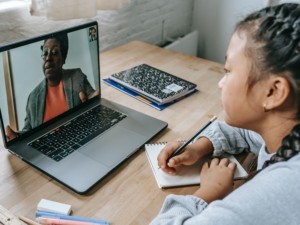10 Tips for Online Student Success

Virtual schools and online learning present unprecedented options for students- the type of flexibility and choice that was not on educators’ radar even 10 years ago. But as online options develop for students, it is important to remember the real benefit is for the student. Online learning isn’t meant to save money or slash school budgets (see what’s happening in Kansas this past week) and it is not meant to diminish the importance of having a good teacher.
Online learning needs basically the same amount of funding as brick and mortar and requires just as highly qualified teachers who are dedicated to their students finding success. Online instruction doesn’t lighten a teacher’s workload, it just makes it look a little different. Florida Virtual School, the well-known provider of online learning for middle and high school students, recognizes that teachers are the key to success.
This week we talked to two of its online educators of the year, Shawn Wigg (HS Math) and Elise Harris (MS Civics) both to whom online learning is not new. They are full-time, online teachers at FLVS and know what it takes for students to succeed in online courses- because they see it every day.
Giving advice to achieve success through online learning could sound very similar to the advice a brick-and-mortar student would hear– many of the best practices overlap. At the same time, learning online takes some shift in mindset and can present a learning curve for all involved.
Here are the top 10 pieces of advice Shawn and Elise had to share from their own experience as full-time, online teachers:
- Provide opportunities for students to collaborate- whether it be through participating in live classes throughout the week or virtually working together on projects. Students need to connect with one another – and connection encourages investment and participation from students, online as well as in a physical classroom.
- Create a strong “triangle” of communication– with the teacher, student and parents. Virtual learning can be like no other experience they have ever had before and students and parents need to know what to expect. Empower the parents with the skills they need to find the data about their students’ progress. Monthly calls keep parents not only informed but excited.
- Keep the student at the center of all decisions– whether it be the methods of instruction or the digital tools and strategies used in class. There is never one way to do things- get to know your students and cater to their personal needs. Remember, as students change, so will those needs.
- Be prepared for a huge shift in mindset- if leaving the brick-and-mortar classroom to teach online. Online teachers are on call way beyond the traditional classroom hours of 8 am to 3 pm. Online students learn at their pace – and a huge part of their success is being able to tap into help and support when they need it.
- Have students keep portfolios- and when teaching online those will definitely be virtual portfolios. A favorite for Shawn Wigg and his students is My Big Campus. Students today need to be able to collect and share the best examples of their work as they continue through their education journey.
- Use the tools that make sense for students– Shawn kept searching for the tools to best support his students within math learning and didn’t stop until he found a prescriptive tool that individualizes the lessons. Elise uses Grom Social to connect with her students- calls and texts are essential, but to add in a safe social network that was actually created by one of her own middle school students has strengthened engagement and relationships she has with her students.
- Recognize the power of positive feedback- because you are not working together in a physical space and facial expressions and body language don’t come into play as much, always remember that verbal positive reinforcement is essential for students. Be generous with it. Elise knows “positive praise goes a long way!”
- Take full advantage of the schedule– students should not be afraid of playing with different times to find what works for them. That never happens at a traditional school. Online students can choose their schedule- even tackle one subject a day, if that works best for their learning style.
- Keep exploring new digital tools– don’t be afraid to adopt new ones. Students can be your number one resource because they are not afraid to grab a new app or tool, experiment, test it and integrate it into their workflow. Teachers can learn so much from the students. Also, search the education section of the app store, go to conferences, reach out to developers and test apps in beta- a lot of times they are free!
- Great professional development is out there– finding opportunities to learn online helps teachers stay connected to what their own students are experiencing. Through a Teaching American History Grant, Elise improves her practice by attending webinars with top social studies scholars from all over the country and visiting historic sites, all powerful experiences that she shares with her students. Shawn taps into organizations like SimpleK12 and iNACOL that support and offer the best resources for online teaching.
Following these tips can help all involved- teachers, parents and, of course, students find success that was not possible before. Teachers like Shawn and Elise connect and work with students from all types of backgrounds and every range of skill set, wanting to improve on their school experience, which is not always easy to provide. But by continuing to build relationships with students and their families and using thoughtful and innovative teaching practices, more students improve and grow through learning online.
FLVS is a Getting Smart Advocacy Partner.








Mary
The most important in the online learning is encourage the interactivity and use the appropriate tools and applications. Nearpod is a tool that I would recommend personally! It encourages students to participate actively, they look much more engaged, those interactive features certainly change the pace of a lesson.